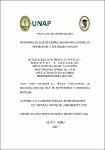Estudio de la alteración máxilo-mandibular en radiografías cefalométricas de pacientes repiradores orales de 6 a 14 años atendidos en la clínica odontológica de la UNAP 2017

View/
Date
2019Author
Cuadros Urteaga, Jorge Fernando
Urteaga Taminche, José Ernesto Zico
Metadata
Show full item recordAbstract
El objetivo del presente trabajo de investigación fue determinar la alteración maxilo-mandibular en radiografías cefalometricas de respiradores orales de 6 a 14 años atendidos en la clínica odontológica de la UNAP. El estudio fue cuantitativo, de tipo descriptivo comparativo, tranversal. La muestra de estudio estuvo conformada por 50 pacientes respiradores orales. Resultados: A la prueba t de Student entre los valores cefalométricos de Ricketts y los valores cefalométricos de la maxila de los pacientes respiradores orales, se encontró diferencias estadísticas en los siguientes parámetros: Profundidad maxilar (p=0,001), Convexidad del Punto A (p=0,002), Angulo del plano palatino (p=0,000); es decir, los valores cefalométricos de la maxila de los pacientes respiradores orales son diferentes a los valores cefalométricos de Ricketts.
No se encontró diferencia estadística en los siguientes parámetros: Convexidad facial (p=0,630), Altura maxilar (p=0,202), y Deflexión craneana (p=0,109); es decir, los valores cefalométricos de la maxila de los pacientes respiradores orales son similares a los valores cefalométricos de Ricketts.
A la prueba t de Student entre los valores cefalométricos de Ricketts y los valores cefalométricos de la mandíbula de los pacientes respiradores orales, se encontró diferencias estadísticas en los siguientes parámetros: Eje facial (p=0,001), Arco mandibular (p=0,000), Largo de base anterior del cráneo (p=0,000), Altura facial posterior (p=0,000), Posición de la rama mandibular (p=0,000) y Cono facial (p=0,005); es decir, los valores cefalométricos de la mandíbula de los pacientes respiradores orales son diferentes a los valores cefalométricos de Ricketts. The objective of the present investigation was to determine the maxillo-mandibular alteration in cephalometric radiographs of oral respirators from 6 to 14 years of age attended in the UNAP dental clinic. The study was quantitative, descriptive, comparative, cross-sectional. The study sample consisted of 50 oral ventilator patients. Results: The Student's t test between the cephalometric values of Ricketts and the cephalometric values of the maxilla of oral respiration patients, found statistical differences in the following parameters: Maxillary depth (p = 0.001), Convexity of Point A (p. = 0.002), Angle of the palatal plane (p = 0.000); that is, the cephalometric values of the maxilla of the oral ventilator patients are different from the cephalometric values of Ricketts. No statistical difference was found in the following parameters: facial convexity (p = 0.630), maxillary height (p = 0.202), and cranial deflection (p = 0.109); that is, the cephalometric values of the maxilla of oral respiration patients are similar to the cephalometric values of Ricketts. The Student's t test between the cephalometric values of Ricketts and the cephalometric values of the jaw of the oral respiration patients, found statistical differences in the following parameters: Facial axis (p = 0.001), Mandibular arc (p = 0.000), Anterior base of the skull (p = 0.000), posterior facial height (p = 0.000), position of the mandibular ramus (p = 0.000) and facial cone (p = 0.005); that is, the cephalometric values of the jaw of the oral respirator patients are different from the cephalometric values of Ricketts.
Collections
- Tesis [49]
The following license files are associated with this item:

